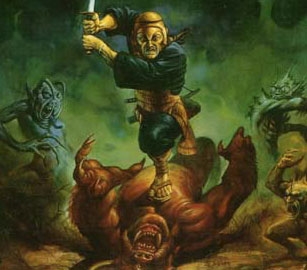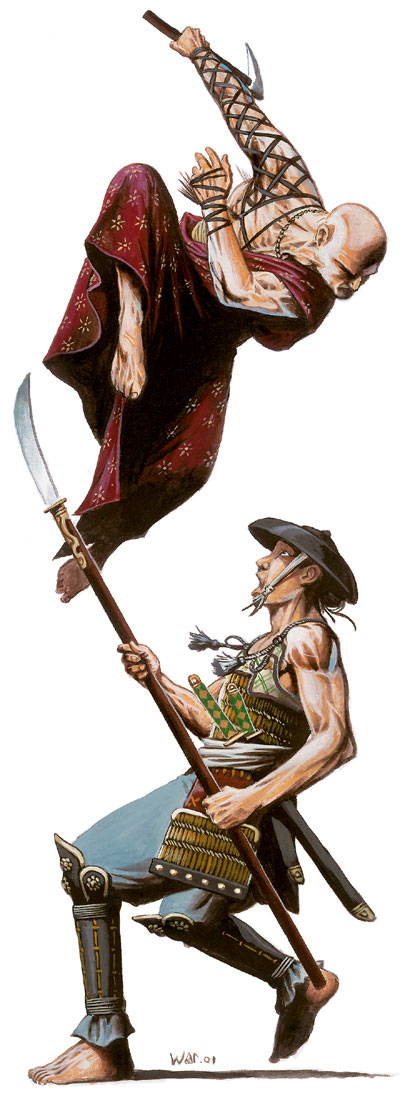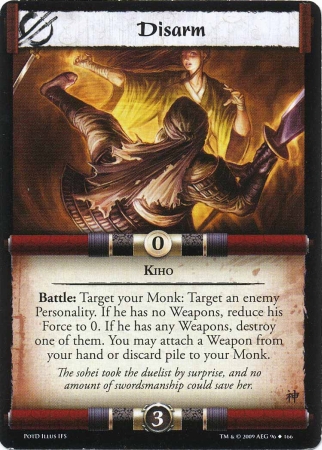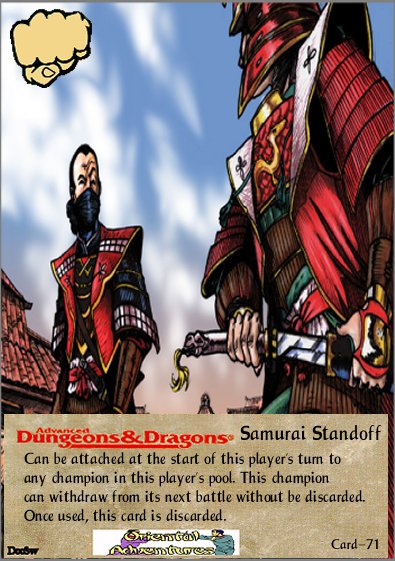COMBAT

COMBAT

|
|
|
|
|
|
|
|
|
|
|
|
The untracked wastes that separate the
OA society from the rest of the AD&D©
game
world have led to differences in styles
and techniques between the two worlds-differences that are more than
just the way people talk, eat, dress,
and behave. These differences even include the conduct of war and the
approach and philosophy to fighting.
Look first at that glorious example of
warlike chivalry, the knight. There he
sits, mounted on his heavy
charger. He is prepared for battle. Iron
plates and rings of chain mail cover him from head to toe. Joints and
vulnerable areas are fitted with angled
plates to deflect the piercing bolts of crossbows and arrows. Fitted over
his head is a heavy armet with a visored
beaver covering his face. He dimly peers onto the battlefield through
narrow slits. The armor is made as thick
as possible to protect him while still letting him move. Strapped to his
left arm is a shield, substantial in size.
Gripped in his right is a heavy shaft of wood, 18 feet or more in length,
tapering to a metal point. On one side
hangs a long, straight double-bladed sword, used to smash through weak
points of his opponent's armor, relying
on the power of his swing and the weight of the sword to cut through
any material. At his other side hangs
a flanged mace, designed to batter against the plates of hardened steel
of
the enemy, dazing and injuring them through
the shock of its blow. His horse is specially bred to bear the
weight of heavy iron banding that encases
its body. It is bred for size and weight to crash through his opponents,
overrunning the footmen through sheer
momentum.
At the knight's side stand his men-at-arms,
dressed in suits of chainmail from head to toe. Each carries a
body shield and weans a close-fitting,
open-faced helm. Clutched in their hands may be heavy slashing swords,
thick-shafted spears, or long steel-tipped
pikes. Some may carry mallets or axes to smash at the legs of
unmounted knights, dropping them helpless
to the ground. Once downed the knight can be speedily dispatched
with 3 thin-bladed dagger.
They cluster in knots around pennons fluttering
from the tips of lances. Only their painted shields, the
crests of their helms, and the decorations
of their horses color the somber line. They are screened in front by
hanks of unarmored archers and mailed
crossbowmen. Well in their midst sits their commander astride his
horse, the standard of his cause fluttering
in the breeze. At the signal of drums or the blare of a horn or the wave
of a flag, they march and charge into
the enemy ranks.
Meanwhile, at the other end of the world,
the samurai and his warriors prepare for battle. The general
sits on a stool, a screen of colored cloths
set up behind him. He surveys his lines of battle. There he sees the
samurai, the warrior ideal of his place
and age.
Like the knight, the samurai sits upon
his horse for the coming battle. His helmet
with its great flaring
neck piece is tied into place. A sculpted
metal mask covers his cheeks and connect to a gorget. His chest is
protected by a breastplate covered with
painted and patterned leather. Great rectangular protectors cover his
upper arms and legs. Metal greaves are
strapped onto his calves. In his belt are strapped his two swords, one
long and one short, but both single-edged
coming to sharp points. With these he slashes and parries, relying on
sharpness and speed. In one hand he holds
a huge lacquered bow that he fires from horseback. In the other a
short naginata-a sharp curved blade on
the end of a pole-with which he slashes at his enemies as he rides
through their lines. Strapped to his side
is a quiver box of arrows. Some are fashioned with beautiful leaf-bladed
heads, others sharp spikes, yet more with
heavy blunt tips and perhaps one on two with carved wooden heads
that whistle and sing as they fly through
the air. His horse, too, is specially bred, but not for mass and power.
Its
body is covered by few ornaments as the
samurai relies on its hardiness and speed in the upcoming fight.
Like the knight, the samurai also has
men-at-arms to stand at his side. They are lightly armored, with
their arms and legs uncovered. They wear
no helms, only iron hats. They carry long naginatas and have their
swords at their sides.
As the general looks upon his men,
he sees waves and waves of color. Bright banners flutter from the
backs of riders, colored silks show underneath
armor, and brilliant rows of lacing form the armor itself. All
await the signal of the drum, the flare
of the rocket, or the sounding of the conch that the battle is to begin.
Whereas the knight relies on the might
of his weapons and the solid strength of his armor, the samurai
depends on his speed and sharpness. He
dresses and fights for speed and deadliness. He does not try to batter
his
opponent into defeat but tries to slash
and cut him down quickly. He does not rely on the might of the charge
(although he can and will do so) but fires
his arrows from horseback. He and the other warriors of the Oriental
world have a different style of fighting.
Next, compare the peasants of the two worlds.
On one hand is the stout yeoman ready to defend his land
with an old sword and a variety
of cruel farming tools fashioned into weapons. The other, in his fields,
his
weapons often confiscated or forbidden,
has learned to fight with other tools his hands, his feet, and a variety
of
small and unusual items. He fights not
only with a different style, but with weapons never considered by the
knight and the peasant of the other half
of the world. He fights not just in a different style, but also a different
technique.
The OA
rules, since they are designed for the AD&D
game system, use the methods
and rules given in the previous AD&D
game books for handling individual combat between groups of
characters and NPCs or creatures. However,
additions to these rules are necessary to cover the new fighting
styles and techniques found in the lands
of OA.
SUMMARY OF THE COMBAT SEQUENCE

To help you understand where some of the
additions to combat occur during the course of play, the steps
of resolving a combat are summarized below.
The OA rules that provide additions
to these
steps are listed in italics where they
appear in the sequence.
1. Determine if either side is surprised.
Characters are normally surprised on a 1-2 on 1d6. There are
often cases where surprise is not possible
due to visibility, surroundings, noise, etc.
2. Players state the actions their characters
are attempting. Players must also announce if their characters
are attempting to subdue, disarm, or unhorse
an opponent.
3. If there is no surprise, roll for initiative
on 1d6. The side with the higher die roll gains the initiative for
the round. Kensai and wu jen characters
are able to modify their die roll.
4. Kensai and wu jen characters with a
higher modified initiative roll than either side make their attacks.
Then, a to hit roll (1d20) is made for
each character on the initiative side attempting to hit. The result is
compared to the Armor Class of the target
on the appropriate combat table for the character class attacking. If
the die roll (including modifiers for
strength, magic, etc.) is equal to or greater than the number listed, the
opponent is hit. Certain characters must
state whether they are using ki power before the die is rolled.
Appropriate saving throws are then made
for characters who are the targets of spells. Shukenja must
state whether they are using ki power
before any saving throw is made.
Appropriate dice for damage are rolled
for each hit, adding in modifiers for strength, magical weapons,
weapons of quality, and ki powers. The
damage done is subtracted from the opponent's current hit points.
Subdual damage is not subtracted, but
recorded separately.
5. The side that lost the initiative now
performs step 4.

Characters who possess the iaijutsu proficiency
have special opportunities to surprise their opponents
because of the lightning speed with which
they draw their weapon. Because of the nature of the skill, however,
this modifier only applies in special
situations. When a character, in a noncombat encounter, decides to
suddenly draw his weapon and attack, the
iaijutsu modifier for surprise is used. A player character and an NPC
are in the midst of heated negotiations.
They are kneeling beside each other, their weapons sheathed. The
situation grows tense and the NPC decides
to attack the player character without warning. Drawing his weapon,
he lunges forward, intent on striking
a deadly blow. At this point surprise rolls are made to see if both sides
are
prepared for the situation. Just how fast
each is able to draw his weapon and prepare for combat is critical. A
player with the iaijutsu proficiency has
a slight advantage over his opponent.
If one character has iaijutsu proficiency
and the other does not, a -1 modifier is applied to the surprise
die roll of the character without the
proficiency. If both characters have iaijutsu proficiency, the -1 modifier
is
applied to both surprise die rolls. This
modifier reflects the startling speed with which the iaijutsu-trained
character is able to get his weapon into
action.
Obviously, this surprise modifier does
not apply to all situations. No modifier is applied when weapons
are already drawn or when the opponent
has reason to expect an attack. The iaijutsu modifier only applies when
an otherwise peaceful situation erupts
into bloody conflict, especially from an unexpected quarter.
At the beginning of each combat round (unless
there is surprise), 1d6 is rolled for initiative.
This
determines which individual or group acts
first in that melee round. Normally, this die roll is unmodified, the
sequence of actions left to chance. However,
characters in the OA world live and rely on their
quickness and speed. Therefore, some have
developed their speed to the point where they have improved
chances of striking the crucial first
blow in a combat.
When modifiers to the initiative only apply
to some of the characters involved in the combat, the
initiative roll is still made only once
for each side. However, those characters with modifiers then apply their
modifier to the die roll for their side-but
for the actions of that character only! Thus, the actions of an initiative
round may be divided into more than two
phases of attacks.
When the initiative (modified or unmodified)
results in a tie result, the die is not rerolled. All characters
or creatures are assumed to be acting
in the same instant. Thus, damage done or the effects of spells are not
applied to a character with the same initiative
until he has completed his action. As soon as he has finished his
action, the character suffers the normal
results of actions against him.
A kensai, a samurai, and a shukenja player
character encounter a group of hostile samurai. All the
characters are 1st level. One initiative
die is rolled for each side. The player characters roll a 3. The NPC party
rolls a 4. The kensai and the NPCs strike
first, all in the same instant (the kensai has a modified initiative of
4).
Next the remaining player characters strike.
If the NPC group had included a kensai, he would have been able to
strike first (with a modified initiative
of 5), followed by the simultaneous attacks of the remaining NPCs and the
player character kensai (and then the
surviving player characters).
When the initiative of one side is greater
than even the highest modified initiative of the other side, all
characters on the winning side can complete
their attacks in whatever order is desired. Their actions are
completed before those of the other side
begin, hence order in this case is unimportant.
| Missile Fire from Horseback | Unhorsing | Disarming | Subduing Opponents | The Psychic Duel |
| - | - | COMBAT | - | - |

At times characters will find it necessary
to disarm an opponent. A party member may be charmed into
attacking his friends or the characters
wish to capture an opponent without being harmed greatly themselves.
Disarming can be done by two methods-parrying
the weapon out of the opponent's grasp through superior
weapon skill or wresting it from his grasp
with one's bare hands.
To disarm with a weapon, the character
must be using a melee weapon of equal or greater size than that
of the victim. He must declare at the
beginning of the round that he is attempting to disarm. A normal to hit
roll
is made but the attack does no damage.
Instead, the victim must pass a saving throw versus petrification or have
the weapon knocked from his grasp. The
weapon falls 1 d6 feet away from the disarmed character. One round is
needed to recover the weapon.
To disarm an opponent with one's bare hands,
the character can use either the weaponless
combat system explained in UA or,
if he has the proficiency, the MA skills explained
later in these rules.
When using MA, the character can attempt
to knock loose a weapon of any size.
The process is the same as that for disarming
with a weapon, except that the victim is allowed a + 2 to his save.
When attempting to disarm a character
using a two-handed weapon, a successful attempt knocks loose only one hand.
Thus two successful disarming attempts
must be made in the same round for the character to be disarmed.
Should only one succeed, the opponent
simply regrips his weapon at the end of the round.
It is sometimes desirable to defeat an
opponent without killing him. This is particularly true of the
shukenja character
class, since they are normally forbidden from killing. Nonetheless, the
shukenja character
needs some method of defeating and overcoming
NPCs and monsters. Furthermore, characters may have the
need to take prisoners or a hostage, both
of which are only useful when they are alive.
Subdual can only be used against creatures
with at least a modicum of Intelligence-they must be of at
least the low Intelligence rating. However,
those of genius Intelligence or greater can only be subdued if they
voluntarily decide to surrender. They
know too well the type of fate that awaits most prisoners. Subdual can
be
used against any kind of creature or NPC,
but a player character can never be forced into submission. Player
characters may decide to surrender, but
this choice is left to the player.
Players must declare any subdual attempt
at the beginning of the fight. After this declaration has been
made, attackers are assumed to be striking
with the blunt edge, flat, haft, butt, pommel, or hilt of their weapon.
Damage from each blow is determined normally,
but only 1/4 of this causes a loss of hit points. The remaining
3/4 is subdual damage. Subdual damage
is recorded separately from the hit points lost. When the subdual
damage exceeds the total starting hit
points (not the current hit points) of the creature or character, the being
is
subdued and surrenders. However, if any
attack is made on the being for normal damage after the declaration to
subdue, the creature will not surrender.
All subdual points disappear and the creature is fought normally.
A subdued creature must stop fighting
and drop its weapons. At this point, if the players can
communicate with the creature they can
attempt to exact an oath from the defeated being. The oath can be some
particular task or promise exacted from
the creature or character, such as "Leave this province never to return;'
"Go to your lord and tell him of your
humiliating defeat;' or "Swear never to haunt this place again." The DM
secretly rolls against the creature's
honor (if it possesses any honor points) or makes a saving throw versus
death
for the subdued creature. If the die roll
is equal to or less than the creature's honor or the saving throw is failed,
it complies with the request. Otherwise,
the creature makes. a show of agreeing but does not honor the request,
instead hoping to wreak vengeance on its
captors at a later time. Alternatively, the victor can choose to keep the
creature captive. In this case, it seeks
the first opportunity to escape. It only remains humble and docile as long
as its captors maintain the upper hand.

Two fearsome samurai
swagger into the dusty street. Toe to toe, they glare menacingly at each
other.
The buzzing of flies is the only sound
to break the silence. Each stands impassive, unflinching. Sweat runnels
down their mustaches. Then, finally, one
of the two makes a sudden move! With a quick bob of his head, he
bows to the other. So defeated, he turns
and tries to lose himself in the gathering crowd. The other grins
broadly-he has won the battle without
even touching his sword!
The encounter described above is a classic
example of the psychic duel-a fierce but hidden struggle
fought between warriors proud of their
skills and their honor. The psychic duel is a type of mental combat that
can be practiced by any character race
or class. It does not require psionic talent. It is a test of the wills
of the
duelists-their courage, skill, and determination.
It is an invisible fight, the outcome revealed by a faint grimace,
the flicker of an eyelid, or the tic of
a muscle. In it, the character displays his mental determination as a warrior,
showing just how tough he is. Will he
attack with wild abandon? Is he cool and calm, confident in his skill?
Is
he willing to risk absolute death in the
coming fight? By showing such fearsome qualities, the character may
win the duel, possibly thus avoiding the
need to fight altogether. Sometimes the wise man is one who
recognizes when he is outmatched and admits
defeat before it actually occurs.
Although the psychic duel can be attempted
by anyone, it can only be done under special circumstances.
It can only be used on or by intelligent
creatures of human or humanoid races. It is strictly a one-on-one duel,
a
single character facing off against another.
It is never used between friends or companions, such an action being
highly insulting and dishonorable for
both (-3 points of honor). The characters cannot have crossed weapons
before during the encounter. Neither can
it be used if they are attacked by others during the course of the
psychic duel. For example, it is not used
in the heat of a furious battle, but it might be used in a challenge before
the battle begins. Likewise, it might
be used on a swaggering bully in the street, forcing him to recognize his
superiors.
To resolve a psychic duel, the characters
spend the round within 10 feet of each other, concentrating
their will. Each then rolls a saving throw
vs. death. Kensai characters have a bonus of + 2 to the roll when
facing non-kensai characters. If one character
makes a successful saving throw and the other does not, the
successful character has won the duel.
If both characters fail the saving throw, the duel is inconclusive and
neither wins. If both characters make
the saving throw, they are locked in the mental battle and the duel
continues for another round. Should one
player break off the duel and attack before it is resolved, he is the loser
(i.e. his nerve has broken).
The winner of a psychic duel gains 2 points
of honor if his opponent is of a higher experience level than
himself. If the two are equal level, the
winner gains 1 point of honor. If the loser is of lower level, the winner
gains no honor for the duel.
The loser of the psychic duel has two options.
He may either retreat, losing points of honor equal to
those gained by the victor, or he can
attack, regardless of the outcome of the psychic duel. However, if he
attacks he is -1 on his initiative, to
hit, and saving throw rolls throughout the ensuing battle. No surprise
roll is
made, since both sides are prepared.